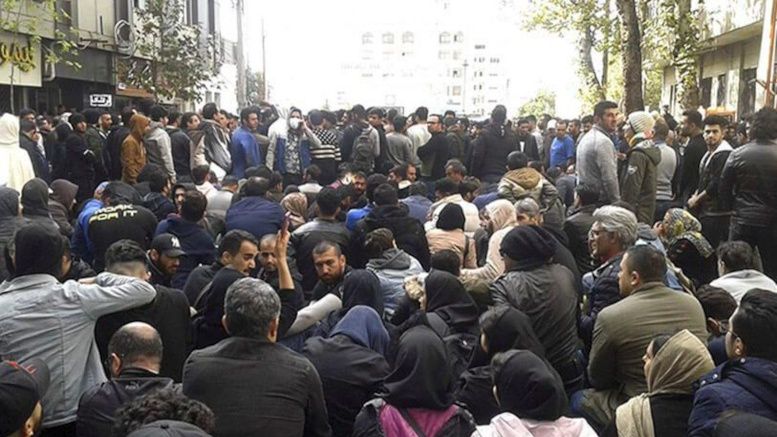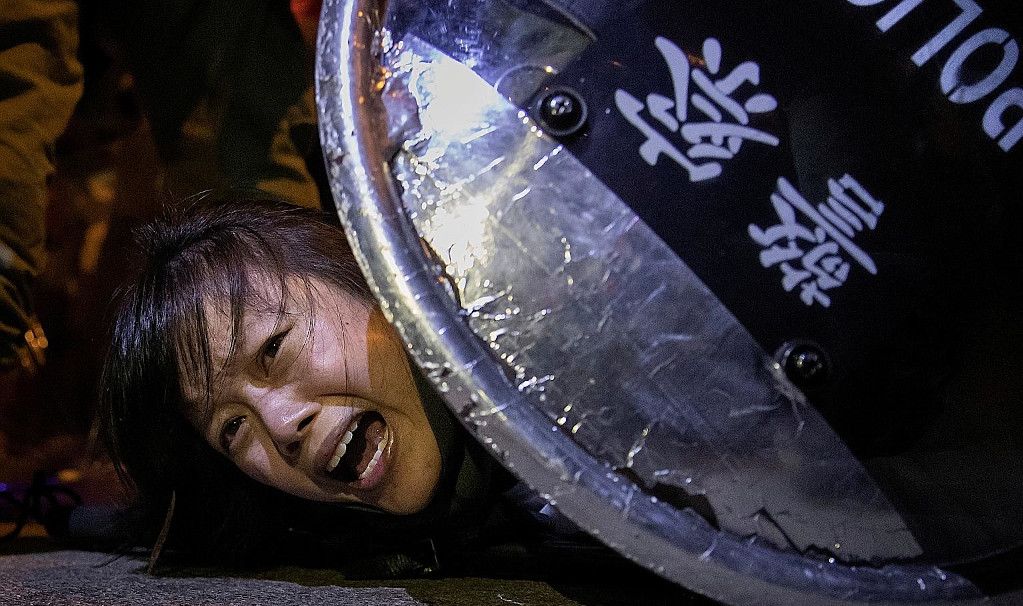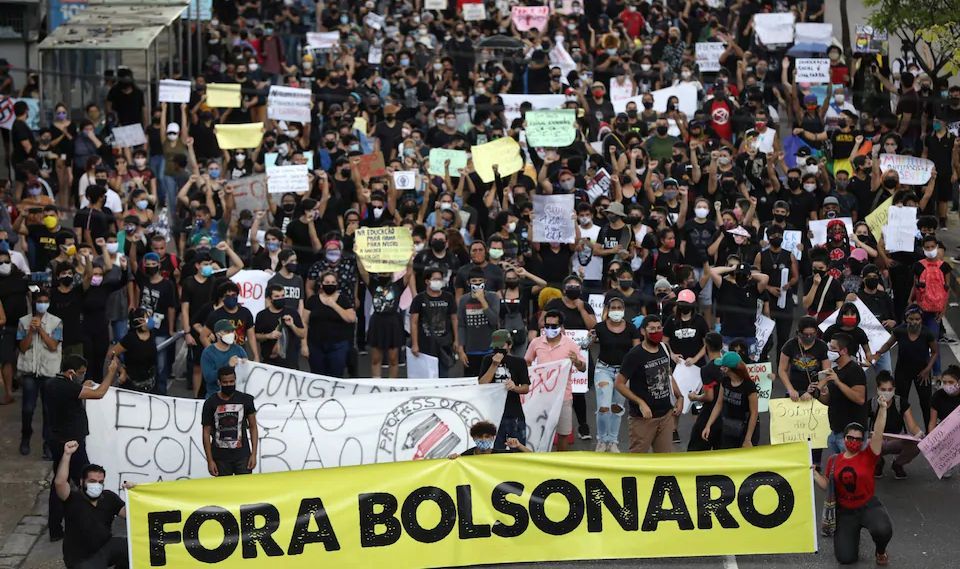Nina Mo is a member of Sozialistische LinksPartei (ISA in Austria).
Since the beginning of this year unrest and protests have continued in Iran with the working class and youth at the forefront. With growing anger about the increased repression of trade unionists, for instance against teachers, and more recently against new executions, as well as protests demanding higher pensions or against water shortage and climate catastrophe, the regime has not had a single calm week.
The latest wave of protests in the province of Khuzestan was provoked first by the government’s removal of subsidies for several imported staple foods in early May, and then fueled by the collapse of the Metropol tower in Abadan where at least 36 people died.
The deplorable living conditions of many people in Khuzestan, the unhealthy climate, inadequate drinking water supplies, exploding youth unemployment, high prices, and this catastrophe have exploded in widespread grief and protest.
Protests against the deadly effects of capitalism, inflation, and corruption
Although President Raisi has promised that “prices of wheat, medicine, and gasoline will not rise under any circumstances” the cost of some foodstuffs has risen by more than 300% in the last weeks. Exacerbated by rising grain prices in the context of the war in Ukraine, the price of flour has grown from an average of 27.000 rials to 160.000 [$3.8]. Last month this led to spontaneous outbreaks of rallies and demonstrations, which quickly inspired protests in other areas as well. At least one protester was shot by the police during associated rioting. The government’s promise of direct aid only calmed the masses for a few days.
Immediately after the collapse of the Metropol building on May 23, the masses of Abadan poured into the streets to protest despite security forces and police reacting with tear gas and arrests. Protesters quickly shouted angry slogans against the Islamic regime, pointing to the deeply rooted corruption and plunder of the area of Khuzestan with only a few super rich mullahs profiting. Slogans like “Death to the dictator,” “Raisi, shame on you, leave the country alone,” “Weapons, tanks are no longer effective, mullahs must go,” “Our enemy is here, they lie by saying it’s America” show the politicized mood. Since there is no leading political force amongst the protests, consciousness is also confused with some protesters demanding a return of the monarchy.
In the aftermath of the tragedy, the Islamic regime, which is losing large parts of its social base every day, was more concerned about the wave of popular protests than sending help to the victims and families. Five days of mourning and a wave of national solidarity had to pass before the government even thought of declaring a public mourning. They partly shut down internet access and prepared their forces to intervene. On the evening of the accident, videos appeared showing a convoy of armored vehicles in the center of the city. They also show security forces using tear gas and warning shots to prevent large gatherings of people.
The collapse of the Metropol building was not the result of a natural or unforeseeable accident, but of the pursuit of profit and accumulation of wealth, intertwined as it is in the nature of capitalism with institutional corruption, the squandering of natural resources and contempt for the lives of ordinary people that is followed by the Iranian regime and their criminal Revolutionary Guards. As long as this system exists, the repetition of one disaster after another has become inevitable.
On the other hand, the reaction of the suffering people reflects a wave of hope for the future. This feeling of solidarity with Abadan amongst the working class and poor around the country shows the way forward. The solidarity protests that have taken place in Tehran and other cities show that whenever the government tries to silence the voice of the people in one corner of the country, the whole of the working class will answer.
Even the Vice-President admitted in an interview on state television that many mistakes had been made in the construction and approval of the building. Repeated warnings by the engineers that construction work on the tower and the three additional floors being added should be stopped were ignored, to avoid damaging the financial deals between the city, the owner of the building and investors.
All those suspected of being responsible for the disaster including the investors will be held accountable, the Prosecutor General has promised. Thirteen people, including the mayor of Abadan and two of his predecessors, have already been arrested as the regime is trying to calm the mood. So far without success. There is still a whole network of corruption and crimes which local and national leaders are trying to cover up, and the working class and poor know that. Protests have continued, going beyond the demand for justice for the victims after the arrest of the mayor.
At the same time, workers at the Abadan refinery have been on strike in protest at the disaster and expressing their condolences to the families of the victims. Official mourning ceremonies were interrupted by angry protesters. The demands of those on the streets also included higher wages, or access to food and water. Khuzestan has a lot of water reserves, but years of destruction and profit-oriented industries have left dramatic water shortages. 700 villages in the region have no water left.
Abadan as a key area for working-class struggle
The area around Abadan is a key part of the country for class struggles as it is the center of the oil industry with one of the world’s biggest refineries and a powerful working class. 90% of Iranian oil comes from the Khuzestan region.
Construction of the Abadan refinery started in 1913 after the discovery of oil in some parts of Khuzestan. This meant an influx to the area of landless, extremely poor peasants from many different cities and regions looking for work. These workers immediately felt the oppression of the British employers and Indian soldiers, they were poorly paid and lived in tents near the refinery. Later, through struggle, they forced the British bosses to build houses and neighborhoods for them. At that time, the city became a very modern industrial center. It was, for example, the first city to have a television station, and advanced cinemas and sports clubs. But over the decades as the oil was plundered, massive exploitation of the workers continued.
This industrial development and the context in which these workers with rural backgrounds and coming from different ethnic and religious groups created a particular situation and culture, which was passed on to the second generation of their children. A culture which was characterized by liberation from all forms of religious bigotry, which is still today not tolerated by the religious rulers.
When moves to nationalize the oil industry began some years later were combined with the activities of the communist Tudeh Party, a large number of workers joined the movement and formed some of the largest and strongest unions in the country. Abadan became the left-wing capital, a thorn in the side of the clergy, who always preached against the people of Abadan, calling them infidels and atheists.
In March 1951, the Anglo-Iranian Oil Company (AIOC) under pressure from below was nationalised with mass support. This triggered an international crisis. The democratically elected government under Mossadegh was then overthrown in 1953, following a coup by Western imperialism and the AIOC was taken over by an international consortium, with Western oil companies profiting massively from that.
In 1978 around 400 people died in an arson attack on a cinema in Abadan. This terror attack on “Cinema Rex” fueled protests against the Shah. During and shortly after the revolution in 1979 Abadan was a key area for communists and trade unionists, being also the first target to be attacked by the counterrevolution with some brutal massacres following. Abadan workers played a crucial role during the 90 day-long national oil workers’ strike which led to the collapse of the monarchy in 1979. In 1980, after the Shah regime was overthrown the refinery was again nationalized into the NIOC (National Iranian Oil Company).
During the Iran-Iraq war, the city came under relentless bombardment by Iraqi forces, people were forced to leave and the city emptied out. Early in the war, hundreds of working-class men and women in and around Abadan had armed themselves to resist the Iraqi forces before the Iranian army could intervene. A long siege ensued, during which large parts of Abadan were destroyed. The pro-regime Basij and Sepah militias seized the opportunity to take control of the city. The destruction of Abadan during the war was a bonus for the mullahs.
After the war, a small number of people returned to the city. Indigenous Arabs who lived around the city started to rebuild working-class neighborhoods. The refinery began to operate initially at minimal capacity. This history of revolution, counterrevolution, destruction, and war is still very dominant in the consciousness of the masses of Abadan and Khuzestan.
Time and again the Khuzestan region has been shaken by angry protests and strikes. In summer 2021, there were widespread demonstrations in Khuzestan and elsewhere in southern Iran because the government had rationed water. The demonstrations were accompanied by a big strike by petrochemical industry workers in Bushehr province. In the following year and into 2022, industrial action continued to intensify, exacerbated by the rising prices and a weakening rial. The anger and radicalization seem to be unstoppable while the regime desperately tries to react with a mixture of concessions and repression.
Overcoming ethnic divisions
One of the most significant developments in the Khuzestan region is the multi-ethnic character of the protests. The masses protesting in the aftermath of the Metropol tower collapse were joined by Arab and Bakhtiari workers and youth. They were dancing traditional Arab dances in the middle of the street protests. This type of solidarity is absolutely crucial and has also played a role in the fact that the regime doesn’t seem to react in the same brutal way as they did, for example, in 2019. The Arab and Bakhtiari tribes are openly armed and not linked to the regime. It seems the regime didn’t dare to risk an armed war with these tribes at this time.
The Arab and Bakhtiari minority, particularly the youth, are some of the most oppressed and poor layers in Iran. This discrimination and oppression have a long history. Especially in the aftermath of the so-called “Green Revolution” in 2009, and during ongoing protests in Khuzestan in 2011, dozens of Ahwazi Arabs were detained, tortured, and executed. Sunni Arabs are not allowed to practice their faith publicly. It is estimated that 90% of Ahwazi Arabs in rural areas suffer from poverty.
The regime tries to promote division and discrimination at workplaces, in neighbourhoods, the education system etc. and use it to stabilize their rule as they also do with Turkish or Kurdish minorities. But the recent waves of protest have shown that the working class and youth are no longer accepting this and have the power to overcome ethnic and religious divisions. In the context of the economic crisis, it is becoming very clear how the ruling class in Iran profits from massive exploitation and poverty and the working class has common interests as a whole to fight back. The movement in Khuzestan will be an example for other areas in the country where minorities are oppressed and discriminated against to reinforce working-class unity.
Ongoing labour struggles: A Socialist perspective is needed to overthrow the regime
The protest wave in Khuzestan is taking place alongside a large number of ongoing working-class struggles, for instance in the education sector but also beyond. Early this year, over 10,000 teachers in over 300 cities went on strike demanding higher wages and free education with women at the forefront. Some of the most militant teachers’ activists have been arrested, as the regime knows their inspirational impact on the broader working-class struggle. Also truck drivers, industrial workers, and pensioners have continued their struggles throughout last year until now. Pensioners are holding regular protests in front of national and local institutions demanding and expressing their solidarity with the teachers, the Abadan people etc.
The spontaneous riots and uprisings against inflation and repression and ongoing labor struggles reinforce each other and are a reflection of the multiple crises the working class in Iran is facing. Low wages and pensions are a massive problem in the face of the economic crisis. The fightback against the regime needs to be developed under a common, socialist program with a perspective to end oppression, poverty and dictatorship. The masses instinctively draw links between the different struggles. In every corner of the country, as soon as a protest breaks out it immediately brings out economic and political demands.
There are significant developments for a rebuilding of a militant workers’ movement, such as the attempt to build a national independent oil workers union, and with more and more coordinated workplace action taking place. Some of the most militant struggles and examples, like the Haft Tappeh workers and their victory or the independent teachers’ union have shown the path the working class has to take to win: by building its own independent organizations and workplace action to put the maximum pressure on the regime and tear down its criminal rule.
Revolutionary developments are clearly on the horizon and the experience of past movements and recent protest waves since 2017 will have an effect on the consciousness of the working-class masses, youth, and poor. In this situation it is crucial to develop a socialist force to bring together these experiences and different struggles, to fight for democratic demands as well as for the desperately needed demands for decent jobs and wages, food, housing, social services, and healthcare.
This can only be provided through democratically organized mass struggle which can end the rule of the super-rich mullahs and overthrow the capitalist system on which it is based, and build a planned, democratic socialist economy and society.




